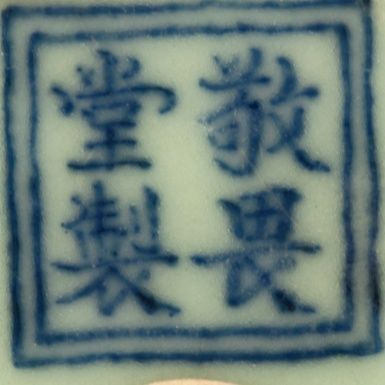A Rare Celadon-Glazed Cuspidor. Qing Dynasty, Yongzheng-Qianlong Period
A Rare Celadon-Glazed Cuspidor. Qing Dynasty, Yongzheng/Qianlong Period - Photo Sotheby's
the domed hemispherical body rising to a waisted neck, surmounted by a wide flaring galleried mouth with a brown-dressed rim, covered overall with a pale sea-green glaze, the base inscribed with a four-character mark reading Jingwei Tang zhi(Made for the Hall of Veneration of Respect) within a double-square; 6.7cm., 2 5/8 in. Estimation: 40,000 - 60,000 GBP
PROVENANCE: Collection of Captain A.T. Warre.
Collection of E.G. Kostolany.
Sotheby’s London, 3rd March 1953, lot 29.The Riesco Collection.
Sotheby’s London, 11th December 1984, lot 420.
Bluett & Sons, London.
EXHIBITED: Celadon Wares, Oriental Ceramic Society, London, 1947, cat. no. 137.
From the Tang to the Qing: Chinese Ceramics from circa 618-1850 A.D. from the Collection of Dr. and Mrs. Peter Thompson, Hull University, Hull, 1996, cat. no. 117.
NOTE DE CATALOGUE: The interest in antiquity permeated the arts of China from the Song dynasty and reached its peak in the 17th and 18th centuries. This rare piece takes its form from spittoon vessels which appeared in China from the Tang dynasty for use in the court and produced in silver, ceramic and glass.
Jingwei Tang was the studio name of Li Hu (alias Duanren, style name Zhucun) a native of Cixi, a city within the subprovincial city of Ningbo, Zhejiang province. Ming Wilson, in the exhibition catalogue Rare Marks on Chinese Ceramics, Victoria and Albert Museum, London, 1998, quotes Wang Qingzheng to suggest that porcelains bearing the Jingwei Tang mark actually belonged to the Manchu high official Agedunbu (see p. 114). Although no supporting evidence is available, Jingwei Tang wares were noted in the Taoya (Ceramic Elegances) of 1906 by the government official Chen Liu (1863-1929) as porcelain with celadon glaze (ibid.). Vessels with the same mark, celadon glaze and brown rim include a bowl and a dish in the Sir Percival David collection, now in the British Museum, London, the bowl included in the Victoria and Albert Museum exhibition, op. cit., cat. no. 47, and the dish published in Margaret Medley, Illustrated Catalogue of Ming and Qing Monochrome Wares, London, 1989, coll. no. A568; and a bowl and cover sold at Christie’s Hong Kong, 29th May 2007, lot 1545. However, not all vessels with this mark are celadon-glazed which may be due to the continued use of the hall for several generations and the subsequent later production of porcelains; see a vase covered with a brown glaze in imitation of a bronze vessel, illustrated in Qingdai ciqi shangjian, Shanghai, 1994, pl. 151; and a pair of blue-glazed cups and saucers sold at Christie’s New York, 18th September 2003, lot 355.
Sotheby's. Chinese Ceramics from the Collection of Peter and Nancy Thompson. London | 07 nov. 2012 www.sothebys.com

/https%3A%2F%2Fprofilepics.canalblog.com%2Fprofilepics%2F1%2F0%2F100183.jpg)
/https%3A%2F%2Fstorage.canalblog.com%2F03%2F02%2F119589%2F96711876_o.jpg)
/https%3A%2F%2Fstorage.canalblog.com%2F11%2F31%2F119589%2F94773502_o.jpg)
/https%3A%2F%2Fstorage.canalblog.com%2F20%2F83%2F119589%2F94772815_o.jpg)
/https%3A%2F%2Fstorage.canalblog.com%2F26%2F72%2F119589%2F75604929_o.jpg)
/https%3A%2F%2Fstorage.canalblog.com%2F59%2F60%2F119589%2F26458628_o.jpg)




/image%2F1371349%2F20240402%2Fob_7227e1_129-1.jpg)
/image%2F1371349%2F20240329%2Fob_2076ee_113-1.jpg)
/http%3A%2F%2Fstorage.canalblog.com%2F92%2F58%2F119589%2F129772574_o.jpg)
/http%3A%2F%2Fstorage.canalblog.com%2F50%2F04%2F119589%2F129632031_o.jpg)